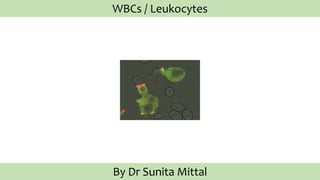lec_13_hematology_wbc_1.pptx
- 1. WBCs / Leukocytes By Dr Sunita Mittal
- 2. Learning Objectives • Introduction to WBCs • Myelopoiesis & its steps • Neutrophil characteristics • Inflammation and signs of inflammation • Role of Neutrophil in inflammation/infection • Causes of Neutrophil number variation
- 3. Introduction – WBCs / Leukocytes Human body is exposed to a number of, diseases causing microbes all the time and but body is equipped with the White blood cells to safeguards from these microbes. We can say that WBCs are mobile units of body’s protective mechanisms (IMMUNITY). Peripheral blood - WBC count= 4000-11000/mm3, Life span 4-8 hours in bloodstream Tissue life span estimated at 4-5 days.
- 4. ▪ Total Leukocytes Count (TLC) 4000–11,000/mm3 ▪ Differential Leukocytes Count (DLC) Absolute value % value Neutrophils 3000–6000 50–70 Eosinophils 150–300 1–4 Basophils o1–100 0.4 Lymphocytes 1500–4000 20–40 Monocytes 300–600 2–8 Normal range of WBCs / Leukocytes
- 5. Introduction – WBCs / Leukocytes WBCs - concerned with non specific immunity- Granulocytes and Monocytes. ▫ Neutrophils ▫ Eosinophils ▫ Basophils WBCs - concerned with specific immunity - Lymphocytes
- 6. Myelopoiesis Myeloid Stem Cells HSC Lymphoid Stem Cells Myeloid Stem Cells → CFU-GM → Myeloblast → Promyelocyte ↓ Polymorphonuclear ← Band form ← Metamyelocyte ← Myelocyte
- 7. Neutrophil ▪ Most Numerous of all leukocytes : 50 – 70% ▪ Diameter : 10 – 14 µ ▪ The Cytoplasm contains closely packed, fine and violet-pink granules ▪ The Nucleus can have 1 – 6 ▪ Function- Neutrophil can cause effective ‘Phagocytosis’ –to kill foreign particles and microbes. Form first line of defense.
- 8. Granules contents (biologically active substances) – Neutrophil
- 9. Neutrophil - Role in Inflammation / Phagocytosis Neutrophil blood cells are very important in combating acute inflammation in body by the process of ‘leukocytes adhesion cascade’ reaction i.e.: Margination, Rolling, Adhesion, Diapedesis Chemotaxis and Phagocytosis
- 10. The five cardinal signs of inflammation— Redness (rubor) Heat (calor) Swelling (tumor) Pain (dolor)—were described by Cornelius Celsus. A fifth consequence of inflammation is the loss of function of the inflamed area, Rudolf Virchow Inflammation and Signs of inflammation
- 11. Neutrophil- Role in Inflammation / Phagocytosis Phagocytosis- Phagesis: to eat, Cytos: cells ‘Process of ingestion and destroying of foreign microbes/antigens’ Endocytosis-Taking in Microbes and cell debris ↓ Formation of Phagosome ↓ lysosome Phagolysosome
- 12. Neutrophilia: Increase in neutrophil=>12000/mm3 Causes- Neutropenia: Decrease in neutrophils= <2000/mm3 Causes- Neutrophil- Causes of variation in Number
- 13. Neutrophil- Leukemia Leukaemia, is a malignant neoplasm that involve HSC in the bone marrow and results in formation of high numbers of abnormal nonfunctional white blood cells (>1 Lac/mm3). These white blood cells are not fully developed and are called blasts or leukemia cells.
- 14. Normal WBC count is --------------------- /mm3 Steps of Myelopoiesis: ……………..→ CFU-GM → …………….→ Promyelocyte→………………. → Metamyelocyte → ……………………Mature form. 30% neutrophil cell nuclei of female contains a small, densely staining structure, consisting of a condensed, inactive …………………known as ……………………... Name 3 important granules contents of neutrophil (biologically active substances)–…………… ‘leukocytes adhesion cascade’ reactions include ……………………………………………… The inflammatory response involves three major stages: first, ………………………….to increase blood flow; second, ……………………………………..from the bloodstream; and third, ……………………………at the site of injury. The five cardinal signs of inflammation are ………………………………………….. of the inflamed area. Name 6 important Released chemokines from injured tissues to mediate inflammation – ………………… Self Assessment
- 15. Thank you














